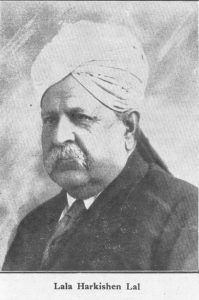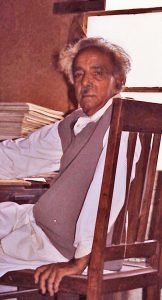LALA HARKISHEN LAL GAUBA AND M.A. RAHMAN CHUGHTAI
PATRONAGE OF A RICH HINDU FOR A RISING MUSLIM ARTIST
Strange anecdotes about the millionaire

The project of Murraqqa-e-Chughtai was on the anvil. Thee were not enough finances. It was decided to get the prints printed from Germany and the rest of the book here in Lahore. As money was limited, a small press was bought and the two brothers, M.A. Rahman Chughtai and Abdur Raheem Chughtai decided to do the printing themselves. The press was placed in the Chabuk Sawaran house, but there was no electricity. A power connection was not available. A request was sent to Lala Harkishen Lal Gauba, and his Shahdara Power station. A special concession was made for the artist and a power connection given at the house of the artist. A rare event. The book got printed there, and the LIMITED EDITION coveted in the world, was all done there. Certainly Gauba had a regard for artists.
Khalid Latif (Kanaya Lal) Gauba writes about his father:

“Although Lala Harkishen Lal built a palace, he preferred himself to live simply in a very small room in the top storey, which was a combined bedroom, dressing-room, and semi-office. For the decoration of this room he commissioned an artist to travel through Punjab and paint all the most interesting beggars he could find. Nearly a hundred types were painted and amidst these, he lived and did the best part of his work. Asked to explain what all this meant, he would say that there are two reasons for this:- Firstly, every man shorn of his trappings, is no better than a beggar, secondly, he personally started life in comparative poverty and having these portraits around him, he would never forget from where he began.”
It would be interesting to know the name of that artist of Lahore who made all these beggar studies for him.
Lala Harkishen died in 1937. M.A. Rahman Chughtai got a set of Murraqqa’s work printed in Austria by Max Jaffe of Vienna. The two works were DESERT IN BOOM and SERENADE (FOR A SONG). It was in 1938 that M.A. Rahman Chughtai was back in Lahore. Some how these two works got into the house of Gauba. As Lal Harkishen died in 1937, it is apparent that these two works were bought by Khalid Lateef Gauba. The proof lies in a letter we received from Bombay, from Khalid Lateef Gauba, after the death of M.A. Rahman Chughtai on 17th January, 1975. The letter said:
“I am very sorry to hear about the death of your father (MARC), who in the East had a position and esteem akin to Picasso in the West.”
Thank you Gauba family!

A sweet incredible man who rose from poverty and fell to poverty again.